|
My past experiences with short term stays in
Provence,
Savoie, and Shanghai only marginally prepared me for my
latest assignment in India. Once again, my employer called
on me to help with a new facility that was being constructed
in the southern Indian city of Chennai. I was to be there
for approximately three months, and I had little time to
prepare. Thankfully, my recent relocation to Texas had at
least helped me acclimate to the insufferable heat that my
Indian colleagues warned me to expect.
Perhaps it was my
enhanced stature in the company or just the way things were
done at my destination, but I didn’t have any of the
logistical issues that I did in my previous assignments. I
was picked up from the airport by a driver. One thing
everyone knows about India is that there are loads of people
– over a billion to be more specific. This was evident from
the onset as we crept along in traffic at 4:30 on a Sunday
morning. Caught up in a swarm of cars, motorbikes,
scooters, and auto rickshaws, I didn’t know at the time
that this wasn’t traffic. Real traffic was what I would
encounter the following day trying to get to and from the
office.
Nevertheless, I was “whisked away” to a service
apartment in an affluent part of town near where I was to
work. Despite the early hour, I was introduced to my
manservant, Kumar, who was to cook for me, clean up after
me, and do my laundry. While my wife would likely disagree,
this is something to which I was unaccustomed, and I
suspected that I would feel very uncomfortable with the
arrangement. But sleeping was the immediate forecast, and
everything else would work itself out later.
Work
the next day began with a tour of the facility and an introduction
to the team. It was immediately evident that this trip would be much more about the work
than the play. In fact, people in the office routinely worked eight hours on Saturday. With
a ribbon cutting ceremony only weeks away, we would be
expected to put in 12 hour days for six days a week as there was
much to be done. That left only Sunday to experience anything outside of the office.
|
|
|
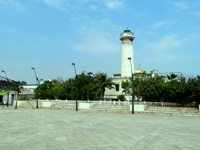
19th century lighthouse
|
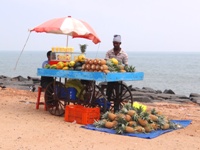
Fragrant pineapples for sale
|
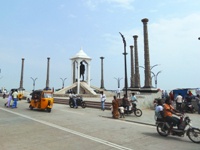
Gandhi watches over the promenade
|
|
|
A few days after my
arrival, I was joined by a colleague from Massachusetts who
would stay for just over a week. As this was his second
time to Chennai, he had pretty much seen all the high points
and didn’t feel much like seeing them again. The only place
that was recommended to us that he had not visited was
Pondicherry. Situated about two hours down the coast,
Pondicherry (now renamed to Puducherry, meaning “new
village” in the Tamil language) was the cornerstone of the
French possessions in India. The French East India Company
set up shop there in 1674 and created a city the only way it
knew how – a grid pattern with boulevards. A French
settlement in British India certainly had its challenges,
but the colony flourished as a major port city. Even after
Indian independence from the British in 1947, Pondicherry
remained in French hands for another seven years.
Today, the unique
Franco-Indian architecture and culture (much of the local
Indian population speaks French) makes Pondicherry a popular
destination for tourists, and its tax-free status makes it a
popular shopping destination for Indians. For my colleague
and I, it meant a two hour drive down the East Coast Road
(ECR) which was itself quite an experience. We zipped past
anything from trucks to cars to motorbikes to livestock; all
on a two lane road where passing in the face of oncoming traffic is
the norm.
It was a relatively hot
day, and my colleague from New England was reluctant to get
out of the air conditioned vehicle. So I was on my own to
look around in the few minutes I was allotted. I walked
along the seawall promenade that the French built in the
18th century to curtail the seaside erosion of the town.
There were a number of vendors selling food and
knickknacks but very few people about. Heading into the
town a bit, there were a large number of people dressed in
their Indian fineries congregating in the shade of trees and
in the park. Many of the buildings in the areas surrounding
the park had that colonial feel but seemed to be in a state
of disrepair.
When I got back to the car, the driver suggested that we
visit the Sri Aurobindo which was supposed to be one
of the more famous ashrams in India. We got there just as it
was closing for the lunchtime hours, so we decided to have
lunch too. We were dropped at a hotel with a buffet which
worked out well because it gave me a chance to try some
different local dishes. Afterwards, my travel companion had
had enough of Pondicherry and suggested we return home. I
felt I had already put him out enough for the day, so didn’t
put up much of a fight. I figured that if I wanted to come
back again, I would have plenty of opportunity over the next
three months.
On our way back to Chennai, our driver insisted that we stop at
Auroville. We had no idea what it was, and the only thing our
driver could offer was that it was a town with many international
people. To his credit, we did see many foreigners riding
around on bicycles while we traveled some back roads to get there.
Despite having spent about 30 minutes walking around, we still had
no idea what this place was. The driver just kept pointing to
the sign that said Matrimandir with an arrow. We found several
more signs that led us on a walk that lasted for about 20 minutes
before our driver pointed to a gate. There in the distance was
a gold domed building. There was no explanation of what it was
and the gate was locked, so we piled into an autorickshaw and asked
the driver to take us back to the car. Later I found out that
Auroville was the brainchild of a French woman who wanted to build a
city that belonged to humanity and where people could live together
and aspire to create a better world. We didn't see much
"aspiring for a better world", just people sitting on the ground
talking. Apparently the dome was a "place of tranquility".
The following day, we got a new driver.
|
|
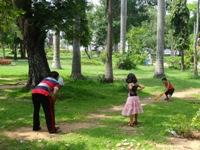
A batsman in the making
|
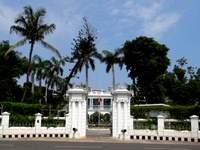
Palais du Gouvernement
|
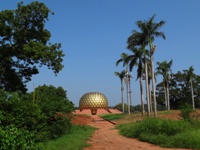
The Matrimandir in Auroville
|
|
|
|
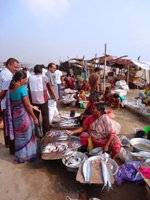
Catches of the day
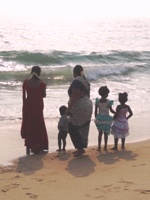
A family dip
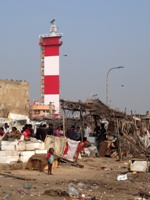
A constant reminder
|
While the northeastern US was hammered by Hurricane
Sandy, southern India was being lashed by Cyclone Nilam. As
the skies darkened, people left work early and the
government announced school closures for the next day.
People were out pruning potentially troublesome branches and
stocking up on supplies. It was a widely accepted fact that
power would be lost. In fact, rolling brown outs are a
daily event. Most upper-class apartments and big businesses
have a UPS and/or a generator to ease the pain. Toward
nightfall, the winds started picking up and pushing debris
around. The rain seemed to hold off with only brief showers
settling some of the dust. As this was monsoon season in
this part of India, rain is nothing new, but water tends to
pool up in the streets for long periods after the rain
stops.
In the end, the storm was milder than feared in Chennai.
To the south, it was reported that winds reached 50 mph and
there was some loss of life. Several coastal towns had been
evacuated, or the toll would have been worse. In and around
my neighborhood, there was visible damage to houses and
walls from fallen tree limbs. Many people were still without
power, but the city was picking itself back up. One of the
more talked about consequences of the cyclone was a large
oil tanker that broke free from its anchorage and ran
aground on Marina Beach – Chennai’s longest urban beach.
Six sailors died trying to abandon the drifting ship. The
tanker became somewhat of an attraction as throngs of people
came to watch the attempts to tow it back into the sea.
Marina Beach is a huge attraction in its own right.
It is India’s longest urban beach and the second longest in
the world at over 8 miles of shoreline along the Bay of
Bengal. Even in winter, families come out to spend a
day on the beach, but stay out of the water because of the
exceptionally strong riptide. Swimming is in fact
illegal at the beach but there are regular drownings in
spite of it. Several pools are available to help deter
swimming in the sea. If the riptide weren’t enough,
pollution is another good reason to stay out of the water.
Sewage flows directly into the sea around Chennai, and the
beach itself is littered with, well, litter.
Just south of the lighthouse, fishermen remove their
catch tangled in their nets. The big stuff is sold
right on the street, while the smaller bargain pickings are
available closer to the water. You can either take
your seafood selections home as is or have them cleaned and cut right there
on the sand. I'm not sure whether it was the polluted
water or the mass of flies, but I decided to pass.
|
|
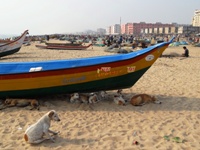
Shade is at a premium
|
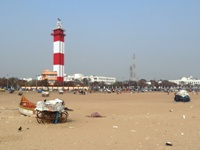
Marina Beach
|
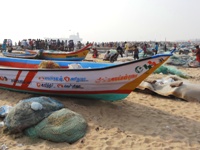
A troubled tanker
|
|
|

